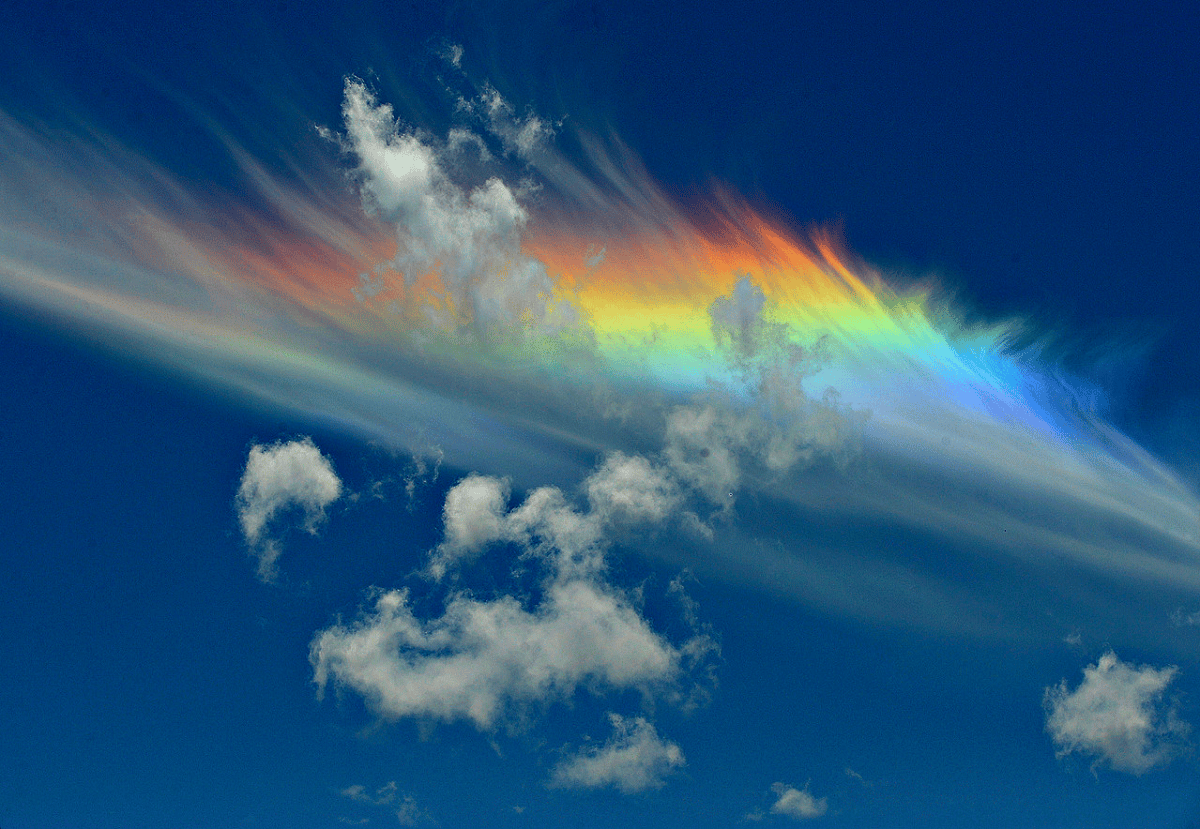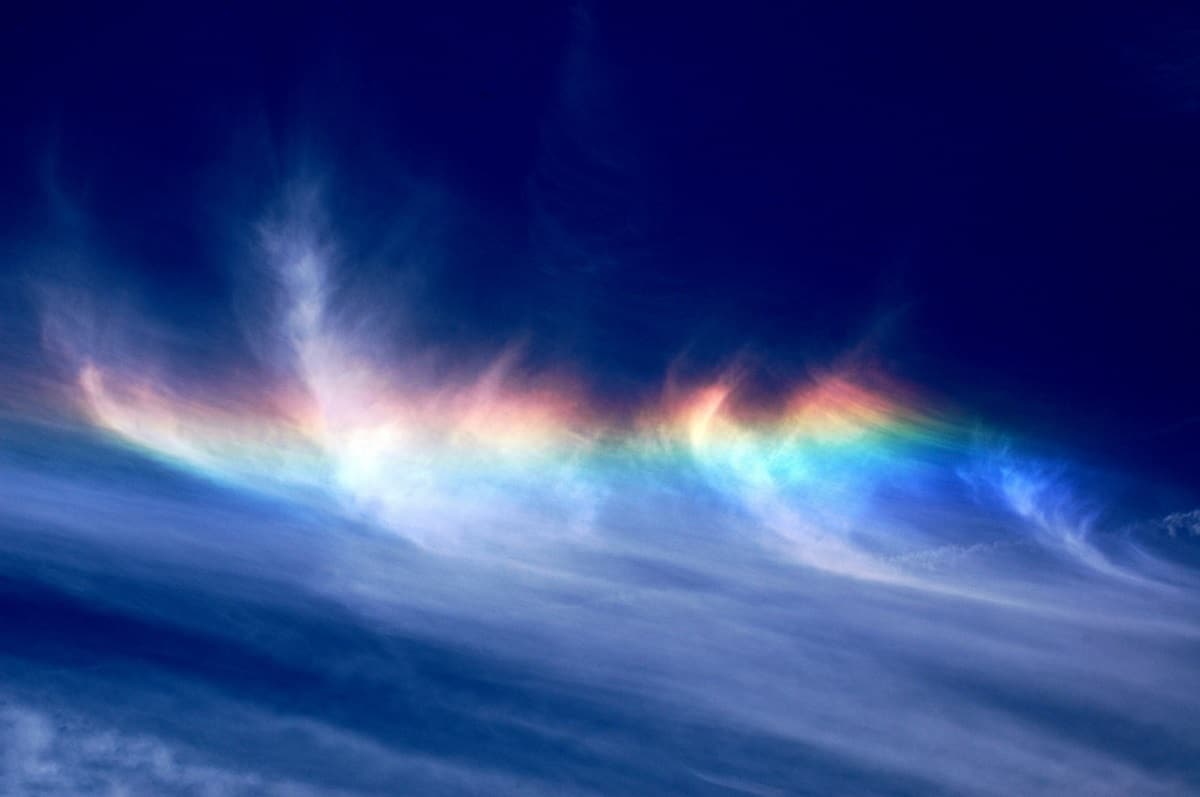
In the field of meteorology, iridescence they are caused by a phenomenon known as iridescence. Iridescences are irregular patches of color in clouds near the sun or even the moon. This optical phenomenon can be explained by partial or imperfect coronas, since they are created by the same light diffraction process as water droplets.
In this article we are going to tell in detail what iridescences are and what aspects they have visually.
What are iridescence

The contours of the clouds, and their delicate translucent filaments, sometimes give us the opportunity to observe beautiful displays of color. The beautiful iridescence that usually occurs in medium to medium sized clouds It is due to the phenomenon of diffraction of light, when radiation from the sun or moon strikes at an angle on a myriad of tiny water droplets and ice crystals of uniform size.
The iridescences are irregularly distributed throughout the cloud, although the most common is that the colors are arranged in bands that occupy the edges of the cloud, although they can also appear as spots. The colors are very pure, subtly blending and occupying shades of green and purple among other colors in the visible spectrum. In medium clouds, the iridescence often takes on a pearly texture. Clouds with iridescent colors are more frequent than previously thought, although this optical phenomenon is often overlooked. Wearing sunglasses helps to see them, especially if the solar disk is covered by trees, buildings, etc. However, sometimes the color is so intense that it is difficult to ignore the phenomenon.
If from our position the sun is close to the clouds, the strong light source will dazzle us and prevent us from seeing the color unless we have the aforementioned sunglasses or a suitable filter, in which case we will succumb to the magical show of light and color . The intensity of the different shades varies a lot, sometimes seeing a perfect mix of bright and very bright colors.
The iridescence is due to the multiple reflections that light undergoes when intercepting small droplets of supercooled water and ice crystals that form the high and medium clouds in ref. One of the keys to this optical phenomenon is the presence of hydrometeors of very similar size. The phenomenon of interference is responsible for separating the different colors at the wavelengths we observe, modulating the incoming light so that the resulting signal is amplified in some areas and attenuated in others.
We can only see the iridescence when we are positioned at the right angle relative to the area of the cloud that generated it. Similar conditions can occur on the surfaces of some everyday objects, such as oil stains, soap bubbles, or the wings of certain butterflies and insects.
Optical effects of iridescence

Our atmosphere is a scene of different meteorological representations, many of which are optical phenomena, created by the interaction of sunlight with water droplets in the adjacent atmosphere, so that our scene is colorful through refraction. Among these, we can name halo, rainbow, day and night, iridescent.
The iridescence, in particular, lacks coronal symmetry, exhibits diffuse, imperfect patches of color in clouds or streaks of color around edges. From the ground, for example, observers see rainbows instead of coronas when clouds are too small to create symmetrical coronal loops, or when the Sun or Moon is not directly behind the cloud.
Iridescent clouds are the result of sunlight diffracting through the tiny water droplets or even tiny ice crystals that make up these clouds, which individually deflect the sun's rays. The larger ice crystals create halos, which are caused by refraction rather than iridescence. It is also different from rainbows caused by refraction in larger droplets for the same reason. If part of the cloud has drops or crystals of similar size, the accumulation of this effect can cause them to take on their color.
This atmospheric phenomenon is almost always confused with a rainbow, when in fact it is a very different phenomenon, despite having formed under the same conditions. The color seen in the rainbow depends on the size of the droplet and the angle from which the observer sees it.
iridescent colors

The blue that forms the inner ring of the crown is usually the dominant color, but red and green can also be seen. The brightness of the color increases with the uniformity of the number and size of the droplets. As with crowns, small, even drops produce the best visual results.
The colors of the rainbow in the visible spectrum include all the colors that can be produced by a single wavelength of visible light, that is, colors of the pure or monochromatic spectrum. the visible spectrum it does not exhaust the colors that humans can distinguish. Desaturated colors like pink or violet variations like magenta cannot be reproduced with a single wavelength.
Although the spectrum is continuous, so there is no white space between one color and another, the ranges above can be used as approximations. Like any illuminated object, in this case, water droplets suspended in the atmosphere absorb part of the electromagnetic waves and reflect the rest. The reflected waves are captured by the eye and interpreted in the brain as different colors according to the corresponding wavelengths, and the rainbow is one of the best known examples of this type of optical phenomenon.
Clouds favorable for iridescence
For this phenomenon to occur, in addition to the occurrence of light and raindrops, a favorable cloud factor is required, in this case the recently formed altostratus or altocumulus clouds provide the best conditions for iridescence. It is worth noting that solar iridescents have more vibrant colors, but many times the intensity of the light prevents them from being seen. In contrast, moonlight produces lighter colors, although these are easier to distinguish.
In our atmosphere, this phenomenon can also occur in other situations, in addition to other factors, such as contrails left by airplanes. The effects of rockets in the upper atmosphere can produce, among other things, very dramatic and spectacular effects.
When a rocket travels through the upper atmosphere, the water vapor from its exhaust crystallizes to form tiny ice crystals. The crystals diffract rising sunlight to produce iridescent colors. There is also a cloud formation very similar to iridescence, the polar stratospheric clouds, also known as pearl clouds or mother-of-pearl clouds, which are clouds of bright pastel hues.
They are made up of tiny ice crystals that they form at a height of between 15 and 30 kilometers at temperatures around -50 °C. Its ice crystals act as catalysts for greenhouse gases emitted by aerosols.
I hope that with this information you can learn more about iridescence and its characteristics.